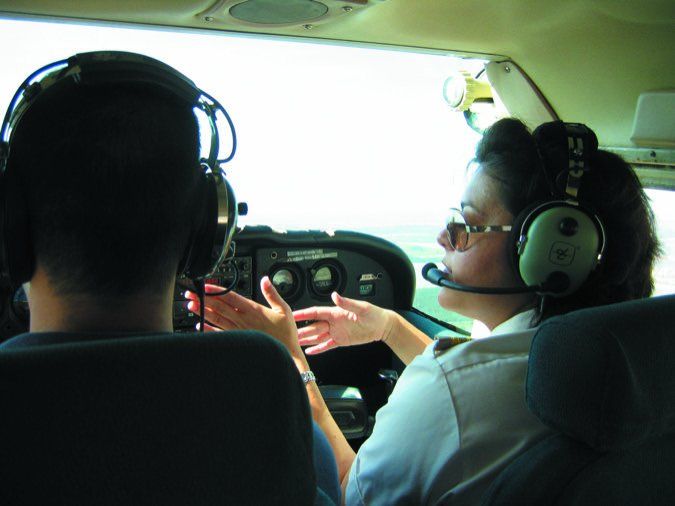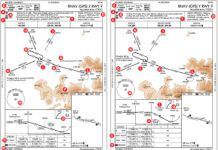(Editor’s note: In 1981 the Professional Air Traffic Controllers Organization, PATCO, illegally struck against the FAA. The controllers were fed up with what many viewed as horrible working conditions that primarily stemmed from an intense adversarial relationship with management. Unfortunately, it’s difficult to cite the reason for striking as “bad management,” so the strike unsuccessfully became mostly about money. Nonetheless, people noticed and many improvements were gradually made. Is it better today? Sometimes and in some places, but not universally. Here’s one veteran controller’s perspective and observations using training to illustrate.)
When asking air traffic controllers about their jobs, you might occasionally get the answer, “Best job in the world.” It’s a demanding, technical career that’s both very rewarding and—while not glamorous—carries a certain mystique with the general public.
However, not all controllers reach that personal and professional “happy place.” Among the many obstacles are the obvious ones, like months or years of on-the-job training and the piles of regulations, charts, and procedures.
However, one of the biggest minefields a new controller must navigate is the very culture of the air traffic control institution itself. The career draws intense personalities. You can hear it yourself as you encounter different cultures at different facilities. Some seem staffed with happy, cooperative folks, while others only offer surly and strident voices.
It can be rough as a pilot, getting snapped at by an irritated controller for something trivial. Imagine being in the belly of the beast as an ATC trainee at one of the not-so-happy places, trying to learn the ropes in an unforgiving environment. Here, controllers of all skills levels speak anonymously of their experience on the journey to the far-off land of certification.

Don’t Get Too Comfortable
“Jimmy,” one controller said. “They just called us all ‘Jimmy.’ No one learned our names.” He’d started in the FAA at a major airport control tower. The veteran controllers apparently made dehumanizing trainees a sport and took pride in their washout rate. The newly hired were held to an arbitrary, unspoken set of standards that none of them could meet. The instructors would staple McDonald’s applications to negative training reports and advise trainees not to buy houses or sign long-term rental leases, telling them they weren’t going to be there long.
Like most other trainees there, this person didn’t even make it on Clearance Delivery. When a controller runs out of allotted training hours, their facility forms a Training Review Board (TRB) made of union and management personnel. The TRB decides whether or not to give the trainee more time, or punt his case up to the National Employee Services Team (NEST). The NEST then decides whether to terminate the trainee, or offer him a less complex facility.
This “Jimmy” got a lucky second chance at a small regional tower. It was a severe pay cut, but he certified quickly and became a rock-solid controller. Oh, and his previous facility? After years of complaints from other trainees that had been shafted, their entire training program got a nice readjustment by some senior FAA folks.
Others aren’t so fortunate. A former military controller was hired into a radar facility. He was a motivated family man, with a newborn at home. With no radar experience, he was facing a challenge. The facility was known for its washout rate, and the trainer they paired him with seemed hell-bent on keeping that streak going. The trainee had only 20 hours under his belt when his instructor decided he wasn’t going to make it. She actually wrote, “Recommend termination of training,” on one of his early training reports. That’d be like washing out of a pilot program after the demo flight.
The typical procedure there was to train on multiple radar scopes, so no one position’s hours get run up too high. She insisted on training him mostly on a single position. He ran out of hours on that one scope—even though he had plenty of hours left on other positions—which triggered a TRB. The trainer got her wish: he was shown the door. He and his family now run an online clothing business.
Defensive Maneuvers
In the shadow of such wasted opportunities, an obvious question bears asking: why not request a different trainer? It’s not that easy. Many facilities are short-staffed, or have a high trainee-to-certified controller ratio. What if a facility has 15 trainees, but only 20 certified controllers to train them? Not much choice available. Even controllers who loathe training are still required to do it. Think they’ll be helping the newbies?
Pilots might encounter the differences between flight instructors who genuinely enjoy teaching, and those just building hours for bigger and better things. The difference between “Iwantto teach” and “Ihaveto teach” has a big impact on training quality.
Changing trainers—if another is available—takes effort. One trainee was a former big-city cop, high school sports coach, and a 10-year veteran of busy ATC facilities. He’d transferred to a new place to be closer to extended family. No newbie to rough environments, he always showed up ready to train, studied hard, and was a team player.
They paired him with a trainer who had three decades of experience, yet no desire to convey that knowledge effectively. During training sessions, the second the trainee made a minor mistake or did something other than expected, the trainer would take over for the rest of the session. Imagine learning to fly without being able to take the controls! The trainer didn’t care. If he was being made to train, he was going to do it his way, even if it sabotaged his trainee’s career.
Unlike the previous trainee, this one had already seen some things and could defend himself by logging the times and dates of bad training incidents, requesting radar and audio replays of questionable situations, formally asking his supervisor about changing trainers, and writing rebuttals on training reports that inaccurately portrayed a situation. Even if this trainee ran out of hours, the vast paper trail he created would be enough to get a second chance. This particular trainee was able to get all-new trainers and easily got certified.
Each controller is, of course, responsible for his or her own career. Newbies may not know those tools exist. Like separating airplanes, seeing a problem in the training environment early enough makes it easier to correct.

Getting Your Ticket Punched
Even if a trainee gets recommended for certification by their trainer, that’s no guarantee they’ll get their ticket punched. The checkride responsibility falls on the trainee’s supervisor. Like the controllers underneath them, some supervisors are good and some aren’t.
At one TRACON, a trainee had been recommended for certification, yet, for three months, his supervisor strung him along, refusing to do a checkride. This led to a demoralized decline in the trainee’s performance. Finally, his trainer—tired of being stuck training on the same sectors again and again—called the supervisor on a recorded landline from the radar room. “He’s ready. If you don’t give him a checkride today, you get him a new trainer, ‘cause I’m done.”
To prove a point, the supervisor simply assigned a new trainer. The trainee languished in limbo for a few more weeks, until the stars apparently aligned. The trainee got a successful checkride.
Another controller transferred to a radar facility, bringing with her 20 years of tower and radar experience. She was already certified on one of several positions. While she’d been handling heavy live traffic continually on the second scope, her supervisor wanted her to see some specific situations that happened only at certain times of the year.
Rather than wait several months, they made her run some intense, realistic simulations. Based on both her real-world and simulation performance, they certified her on the second scope. She went home for the weekend, happy and relieved to be moving forward.
When she came back on Monday, she found they’d pulled her new certification. A fellow controller—who apparently had some previously unknown bone to pick with her—had gleefully run to the supervisor and pointed out that simulations were no longer allowed to be used for certifications, even though he’d been certified via simulations before the recent rules change. So had the trainee’s primary instructor, but they’d pulled the ladder up behind them.
They made her go through the entire checkride again. While she passed, the experience soured her on ATC. She didn’t blame the rule change. This was just the last straw of many frustrations she’d experienced at that facility. She just couldn’t see herself spending the next 10 years dealing with more backstabbing coworkers, inept supervisors, or transferring to yet another place and restarting training again. A month later, she hung up her headset, walked away from ATC entirely, and went back to college.
A Friend in Need
Controllers, for all their intense ups and downs, do take care of their own. This comes both from empathy for their peers and the objective knowledge that controllers need to be at their undistracted best when working. Anyone who’s seen season two ofBreaking Badcan visualize what happens when a controller’s personal life gets in the way of his professional one.
One controller opened up his control tower with another controller who appeared visibly upset. He asked her what was troubling her. In a sudden torrent of words and tears, she revealed that her spouse had assaulted her. She’d had him arrested a few days earlier and that morning was his court hearing. Unfortunately, management had denied her leave request to ensure there’d be two openers, in case one got sick.
The first controller immediately took over her frequencies, approved her leave, and sent her on her way. He stepped up and handled all the traffic on his own until the next shift rolled in. The other controller clearly didn’t need to be talking to airplanes in her distracted state.
Another controller arrived at work and found Tower being worked by a coworker who had been on leave for a week, visiting his sick father. “Hey,” the first one asked casually, “how’s your dad feeling?” His buddy gave him an odd, shaky look and said, “He died this morning.” It turned out that between looking out for his dad and his ill mother, he’d used up all his sick leave, and didn’t have any left for himself to take that awful day.
Shortly thereafter, the grieving controller was relieved from position, sent downstairs, and given some light administrative duties. Every other controller there that day gave it to him willingly, taking short breaks and working more to give their friend some time to collect himself and handle his family matters.
In flying, it’s great practice to preflight yourself before you preflight the airplane. Sometimes you can feel when you’re out of sorts and stay grounded. Other times, it takes the concerned eye of a friend or a coworker to catch when you’ve had all that life can throw at you. In those moments, it’s time to let someone else take the wheel.
Swinging the Boat Around
While bad ATC training experiences continue to happen, the culture is changing. A certified controller at one facility said, “If I’m on someone’s training team, I’m their champion. Sure, the trainee has to step up, study, and get the job done. But I also have to do my part. Their career and their family depend on me doing my absolute best to guide them through the training program. They might wash out, but it shouldn’t be because the people around them didn’t give them every opportunity to succeed.”
Another certified controller talked about two trainees at his tower. Both, at different times, had been stuck with the same trainer, a former Marine who browbeat their confidence into the ground. TheFull Metal Jacketapproach might work with some trainees, but not everyone responds to abuse. To make it worse, the instruction they received was at times flat-out wrong. If a trainee dared pull out the books and show the instructor the correct rule, he received only belligerence in response.
A TRB was convened for each. The members were appalled at the situation. Both trainees were sent to the opposite side of the schedule and paired with better instructors who methodically worked through each trainee’s weaknesses. Within months, each trainee certified and was confidently controlling traffic.
Those whose careers survive the various gauntlets often reflect on their time as trainees. Changing the big machine can only happen from within. “I was treated like crap when I first got in the FAA,” said one controller. “I vowed that, when I got certified and started instructing, I’d never treat a trainee with the same disrespect I received.” Ten years in, he’s stuck to his promise. All but one of his many trainees certified.
That brings up an unfailing truth: ATC is a tough gig. Scary things can happen if someone unqualified slips through the certification cracks. Some facilities—like those in the New York, Washington D.C., and Atlanta metropolitan areas—are veritable meat grinders whose SEAL Team Six-level training programs are the stuff of legend. Even those facilities with friendlier training environments still regularly wash people out. If you can’t do the job, you don’t certify, an objective fact that can be gut-wrenching for an instructor whose trainee just isn’t getting it. The safety of people and property isn’t something that can be compromised.
In any training environment, there’s the chance for failure. Sometimes the trainee is the crux of the problem. Not showing up for work prepared, wielding a negative or entitled attitude, and general laziness can quickly put a target on their back. However, the trainees who study, follow the rules, and are eager to learn at least deserve the respect of a fair shot at “the best job in the world.”




